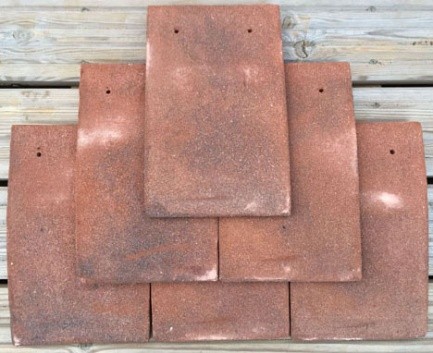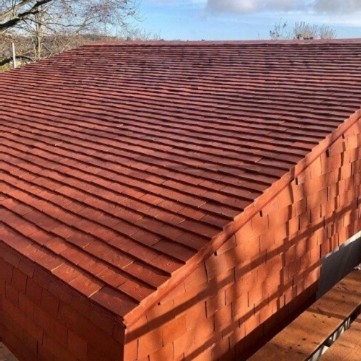Handmade Clay Tiles in Surrey
Heritage Tiles: Emblematic of the finest craftsmanship
Heritage tiles are the professional roofer's choice for the highest quality clay roof tiles. We pride ourselves in manufacturing, stocking, and delivering the very finest in prestige clay roof tiles.
Heritage Tiles have several tile ranges that satisfy every architectural requirement. Vintage and historic properties right up to modern new builds are covered by the diverse range of clay roof tiles that we stock.
So, whether you are in the building trade, or simply wish to choose your own tiles, Heritage Tiles have the right product for your specific requirements.
What Heritage Tiles have to offer our customers?
- We offer specification and technical solutions to help you achieve the perfect build.
- We also offer expert design advice to all our customers.
- We are happy to engage in site visits with our clients.
- We have stockists and distributors throughout the United Kingdom to ensure that we can provide our expert service to a wider area.
- We can provide estimated quantities from plans supplied by our clients.
- We offer battening plans.
- We can deliver a standard and bespoke colour choice for our clay tile products.
- All our tiles are assessed and approved by Lucideon.
- We provide a nationwide delivery and collection service.
The ranges of clay roof tiles we supply.
The Clayhall Range of roof tiles:

Clayhall Medium Blend - Carefully crafted to replicate all the features of handmade the Clayhall hand crafted range of tiles offers an excellent alternative when budget restrictions are a concern, but without compromising quality or durability.
Clayhall Dark Blend - Quality and durability in a budget clay roof tile. The Clayhall dark blend is sure to turn heads.
Clayhall Red Blend - A beautiful rustic clay roof tile. The Clayhall red blend is a firm favourite with our customers.
Clayhall Hamlet Mix - The Clayhall Hamlet mix is a gorgeous light and sandy looking clay roof tile that is a perennial favourite in the building trade.
Clayhall Birchwood Mix - The Clayhall Birchwood mix offers a gorgeous blend of lighter and darker shades in this diverse clay roof tile. If you are concerned that your roof tiles could look monotonous, the Clayhall Birchwood mix is the clay roof tile to choose.
The Conservation Range of roof tiles

The Conservation range of roof tiles are available in a range of distinctive colours, created by using a very fine sand, The Conservation Weathered; A natural warm tone, achieving an instant mellow and settled look and The Conservation Red; perfect for vertical tiling especially suited for villages and hamlets with olde world vernacular charm.
Manufactured using high quality clay, achieving high strength and durability properties, giving homeowners and contractors peace of mind for many years to come. The conservation range comes with a complete set of associated fittings, including Hog Back Ridge, Half Round Ridge, Bonnet Hips, Valley tiles and External Angles.
The Conservation range of clay roof tiles comes in the following variations:
- Conservation Red
- Conservation Weathered
- Conservation Dark
Conservation Peg Tile
Plain clay roofing tiles laid to a double lap have been used for roof covering in England since before the Norman Conquest and tiles dating back to Roman Times have been discovered under excavation. From the outset clay plain tiles were made incorporating fixing features.
The Classic Edwardian roof tile
The Classic range of plain tiles is one of the finest ranges of clay tiles.
We source only the best raw materials for our craftsman to create beautifully handmade clay tiles of the highest quality and durability.
Tile Fittings available from Heritage Tiles
There are many fittings that are available from us a Heritage Tiles to complete your build to perfection. We stock and supply the following:
- Gable Tile
- Eave Tile
- Baby Porch Ridge
- 90 Degree Ext. Angle
- Universal Bonnet Hip
- Half Round Ridge
- Hogs Back Ridge
- Mono Ridge
- Third Round Ridge
- Universal Valley
- Ornamental Club
- Bat Tile Set
Bat Tiles:
Provide help for our bats with our range of bat friendly roof tiles.
Did you know that all UK bats and their roosts are protected by law? The Wildlife and Countryside Act introduced in 1981, gave legal protection to all bat species and their roosts in England.
Distinct species of bats prefer differing places to roost. The two most usually found species of bat in the UK are the Pipistrelle and Brown Long-Eared Bat. Pipistrelle prefer confined spaces such as under tiles on roofs and hanging spaces. The Brown Long-Eared Bat prefer roof timbers and ridges inside lofts. Heritage Clay Tiles can provide purpose made access points within your roof tiles or ridge tiles. The Bat Tile Set can form part of a mitigation package required by law for existing roosts or as potential access where a roost had not previously been present.
Select a Blend
Getting the right blend for your roofing project can feel daunting, but with our blend generator you can mix and match various blends of tiles to achieve the perfect blend.
Click here to make use of our online tool to choose your own unique blend.
Because our strict quality control provides a consistent tile size you can mix assorted styles and colours of tiles to make your roof unique to you. Please use the tool below to experiment with various blends.
Adjust the sliders to set the ingredients for your desired blend then click on the update mix button.
Alternatively click on any blend or tile to display it.
Whatever type of clay roof tile you want, Heritage Tiles will be able to help.
Handmade Clay Tiles
Heritage Clay Tiles Ltd have been in the clay tile business for many years and have developed an enviable reputation for excellence by offering our customers that little extra special personal service, coupled with the very highest quality handmade clay tiles.
All our handmade clay tiles carry a fifty year guarantee so you have the added peace of mind when you choose market leaders like us for your handmade clay tiles.
Heritage Clay Tiles Ltd have over fifty years industry experience. We are very proud of the professional team we have here at Heritage Clay Tiles Ltd.
We are the United Kingdoms leading supplier of high quality handmade clay roof tiles, peg tiles and machine made tiles. You would be hard pressed to find a better supplier for your handmade clay tile requirements.
Our handmade clay tiles are manufactured using traditional skills coupled with modern kiln technology, the Heritage Tile range is literally second to none, offering old world character and charm, yet able to meet modern building requirements.
With a wide and varied colour choice, including innovative shades and bespoke styles available, we offer the architect or homeowner complete control over the handmade clay tiles they need to create a stunning design that will enhance any building project.
A little information about Surrey
Modern Surrey history
Prior to the Great Reform Act of 1832, Surrey returned fourteen Members of Parliament, two representing the county and two each from the six boroughs of Bletchingley, Gatton, Guildford, Haslemere, Reigate and Southwark. For two centuries before the Reform Act, the dominant political network in Surrey was that of the Onslows of Clandon Park, a gentry family established in the county from the early 17th century, who were raised to the peerage in 1716. Members of the family won at least one of two county seats in Surrey, all but three of the thirty general elections between 1628 and 1768, while they took one or both of the seats for their local borough of Guildford in every election from 1660 to 1830, usually representing the Whig Party after its emergence in the late 1670s. Successive heads of the family held the post of Lord Lieutenant of Surrey continuously from 1716 to 1814.
Until the modern era Surrey, apart from its northeastern corner, was quite sparsely populated in comparison with many other parts of southern England, and remained quite rustic despite its short distance to London. Communications began to improve, and the influence of London to increase, with the development of turnpike roads and a stagecoach system in the 18th century. A far more important transformation followed with the arrival of the railways, beginning by the end of the 1830s.
Transport and the commuter in Surrey
The availability of rapid transport enabled prosperous London workers to settle all across Surrey and travel daily to work in the capital. This phenomenon of commuting brought explosive growth to the Surrey population and wealth, and tied its economy and society closely to London.
There was rapid expansion in existing towns like Guildford, Farnham, and most spectacularly Croydon, while new towns such as Woking and Redhill emerged beside the railway lines. The huge numbers of incomers to the county and the transformation of rural, farming communities into a commuter belt contributed to a decline in the traditional local culture, including the gradual demise of the distinctive Surrey dialect. This may have survived among the Surrey men into the late 19th Century, but is now lost in time.
At this time London itself spread quickly across north eastern Surrey. In 1800 it extended only to Vauxhall; one hundred years later the growth had reached as far as Putney and Streatham. This expansion was reflected in the creation of the County of London in 1889, detaching the areas subsumed by the city from Surrey. The expansion of London continued in the 20th century, engulfing Croydon, Kingston and many smaller settlements. This led to a further contraction of Surrey in 1965 with the creation of Greater London, under the London Government Act 1963; however, Staines and Sunbury on Thames, previously in Middlesex, were transferred to Surrey, extending the county across the Thames. Surrey boundaries were altered again in 1974 when Gatwick Airport was transferred to West Sussex.
The United Kingdoms first crematorium in Surrey
In 1849 Brookwood Cemetery was established near Woking to serve the population of London, connected to the capital by its own railway service. It soon developed into the largest burial ground in the world. Woking was also the site of Britains first ever crematorium, which opened in 1878, and its first mosque, founded in 1889. In 1881 Godalming became the first town in the world with a public electricity supply.
The eastern part of Surrey was transferred from the Diocese of Winchester to that of Rochester in 1877. In 1905 this area was separated to form a new Diocese of Southwark. The rest of the county, together with part of eastern Hampshire, was separated from Winchester in 1927 to become the Diocese of Guildford, whose cathedral was consecrated in 1961.
Architecture and industry in Surrey
During the later 19th century Surrey became important in the development of architecture in Britain and the wider world. Its traditional building forms made a significant contribution to the revival architecture associated with the Arts and Crafts Movement, and would exert a lasting influence. The prominence of Surrey peaked in the 1890s, when it was the focus for globally important developments in domestic architecture, in particular work that was influenced by traditional styles and materials.
The late 19th and early 20th centuries saw the demise of long lived Surrey industries that had been manufacturing paper and gunpowder. Most of the counties paper mills closed in the years after 1870, and the last survivor closed in 1928. Gunpowder production fell victim to the First World War, which brought about a huge expansion of the British munitions industry, followed by sharp contraction and consolidation when the war ended, leading to the closure of the Surrey powder mills.
New industrial developments included the establishment of the vehicle manufacturers Dennis Brothers in Guildford in 1895. Beginning as a maker of bicycles and then of cars, the firm soon shifted into the production of commercial and utility vehicles, becoming internationally important as a manufacturer of fire engines and buses, we still see Dennis on the front grill of fire engines to this very day. Though much reduced in size and despite multiple changes of ownership, this business continues to operate in Guildford. Kingston and nearby Ham became a centre of aircraft manufacturing, with the establishment in 1912 of the Sopwith Aviation Company and in 1920 of its successor H.G. Hawker Engineering, which later became Hawker Aviation and then Hawker Siddeley.
The war effort
During the Second World War a section of the GHQ Stop Line, a system of pillboxes, gun emplacements, anti tank obstacles and other fortifications, was constructed along the North Downs. This line, running from Somerset to Yorkshire, was intended as the principal fixed defence of London and the industrial core of England against the threat of invasion. German invasion plans envisaged that the main thrust of their advance inland would cross the North Downs at the gap in the ridge formed by the Wey valley, thus colliding with the defence line around Guildford.
Between the wars Croydon Airport, opened in 1920, served as the main airport for London, but it was superseded after the Second World War by Heathrow, and closed in 1959. Gatwick Airport, where commercial flights began in 1933, expanded greatly in the 1950s and 1960s, but the area occupied by the airport was transferred from Surrey to West Sussex in 1974.
Products available from Heritage Clay Tiles Ltd in East Sussex
Clay Roof Tiles in East Sussex
Clayhall Roof Tiles in East Sussex
Conservation Roof Tiles in East Sussex
Edwardian Roof Tiles in East Sussex
Victorian Roof Tiles in East Sussex
Georgian Roof Tiles in East Sussex
Handmade Clay Tiles in East Sussex
Handmade Roof Tiles in East Sussex
High Quality Roof Tiles in East Sussex
Traditional clay tiles in East Sussex
Traditional roof tiles in East Sussex
Products available from Heritage Clay Tiles Ltd in Essex
Conservation Roof Tiles in Essex
High Quality Roof Tiles in Essex
Traditional clay tiles in Essex
Traditional roof tiles in Essex
Products available from Heritage Clay Tiles Ltd in Hampshire
Clayhall Roof Tiles in Hampshire
Conservation Roof Tiles in Hampshire
Edwardian Roof Tiles in Hampshire
Victorian Roof Tiles in Hampshire
Georgian Roof Tiles in Hampshire
Handmade Clay Tiles in Hampshire
Handmade Roof Tiles in Hampshire
High Quality Roof Tiles in Hampshire
Traditional clay tiles in Hampshire
Traditional roof tiles in Hampshire
Products available from Heritage Clay Tiles Ltd in Hertfordshire
Clay Roof Tiles in Hertfordshire
Clayhall Roof Tiles in Hertfordshire
Conservation Roof Tiles in Hertfordshire
Edwardian Roof Tiles in Hertfordshire
Victorian Roof Tiles in Hertfordshire
Georgian Roof Tiles in Hertfordshire
Handmade Clay Tiles in Hertfordshire
Handmade Roof Tiles in Hertfordshire
High Quality Roof Tiles in Hertfordshire
Traditional clay tiles in Hertfordshire
Traditional roof tiles in Hertfordshire
Products available from Heritage Clay Tiles Ltd in Kent
Conservation Roof Tiles in Kent
High Quality Roof Tiles in Kent
Traditional clay tiles in Kent
Traditional roof tiles in Kent
Products available from Heritage Clay Tiles Ltd in London
Conservation Roof Tiles in London
Edwardian Roof Tiles in London
Victorian Roof Tiles in London
High Quality Roof Tiles in London
Traditional clay tiles in London
Traditional roof tiles in London
Products available from Heritage Clay Tiles Ltd in Surrey
Conservation Roof Tiles in Surrey
Edwardian Roof Tiles in Surrey
Victorian Roof Tiles in Surrey
High Quality Roof Tiles in Surrey
Traditional clay tiles in Surrey
Traditional roof tiles in Surrey
Products available from Heritage Clay Tiles Ltd in West Sussex
Clay Roof Tiles in West Sussex
Clayhall Roof Tiles in West Sussex
Conservation Roof Tiles in West Sussex
Edwardian Roof Tiles in West Sussex
Victorian Roof Tiles in West Sussex
Georgian Roof Tiles in West Sussex
Handmade Clay Tiles in West Sussex
Handmade Roof Tiles in West Sussex
High Quality Roof Tiles in West Sussex
Traditional clay tiles in West Sussex
Traditional roof tiles in West Sussex
Products available from Heritage Clay Tiles Ltd in Bedfordshire
Clay Roof Tiles in Bedfordshire
Clayhall Roof Tiles in Bedfordshire
Conservation Roof Tiles in Bedfordshire
Edwardian Roof Tiles in Bedfordshire
Victorian Roof Tiles in Bedfordshire
Georgian Roof Tiles in Bedfordshire
Handmade Clay Tiles in Bedfordshire
Handmade Roof Tiles in Bedfordshire
High Quality Roof Tiles in Bedfordshire
Traditional clay tiles in Bedfordshire
Traditional roof tiles in Bedfordshire
Products available from Heritage Clay Tiles Ltd in Berkshire
Clayhall Roof Tiles in Berkshire
Conservation Roof Tiles in Berkshire
Edwardian Roof Tiles in Berkshire
Victorian Roof Tiles in Berkshire
Georgian Roof Tiles in Berkshire
Handmade Clay Tiles in Berkshire
Handmade Roof Tiles in Berkshire
High Quality Roof Tiles in Berkshire
Traditional clay tiles in Berkshire
Traditional roof tiles in Berkshire
Products available from Heritage Clay Tiles Ltd in Buckinghamshire
Clay Roof Tiles in Buckinghamshire
Clayhall Roof Tiles in Buckinghamshire
Conservation Roof Tiles in Buckinghamshire
Edwardian Roof Tiles in Buckinghamshire
Victorian Roof Tiles in Buckinghamshire
Georgian Roof Tiles in Buckinghamshire
Handmade Clay Tiles in Buckinghamshire
Handmade Roof Tiles in Buckinghamshire
High Quality Roof Tiles in Buckinghamshire
Traditional clay tiles in Buckinghamshire
Traditional roof tiles in Buckinghamshire
Products available from Heritage Clay Tiles Ltd in Cambridgeshire
Clay Roof Tiles in Cambridgeshire
Clayhall Roof Tiles in Cambridgeshire
Conservation Roof Tiles in Cambridgeshire
Edwardian Roof Tiles in Cambridgeshire
Victorian Roof Tiles in Cambridgeshire
Georgian Roof Tiles in Cambridgeshire
Handmade Clay Tiles in Cambridgeshire
Handmade Roof Tiles in Cambridgeshire
High Quality Roof Tiles in Cambridgeshire
Traditional clay tiles in Cambridgeshire
Traditional roof tiles in Cambridgeshire
Products available from Heritage Clay Tiles Ltd in Oxfordshire
Clay Roof Tiles in Oxfordshire
Clayhall Roof Tiles in Oxfordshire
Conservation Roof Tiles in Oxfordshire
Edwardian Roof Tiles in Oxfordshire
Victorian Roof Tiles in Oxfordshire
Georgian Roof Tiles in Oxfordshire
Handmade Clay Tiles in Oxfordshire
Handmade Roof Tiles in Oxfordshire
High Quality Roof Tiles in Oxfordshire
Traditional clay tiles in Oxfordshire
Traditional roof tiles in Oxfordshire
Products available from Heritage Clay Tiles Ltd in Suffolk
Clayhall Roof Tiles in Suffolk
Conservation Roof Tiles in Suffolk
Edwardian Roof Tiles in Suffolk
Victorian Roof Tiles in Suffolk
Georgian Roof Tiles in Suffolk
Handmade Clay Tiles in Suffolk
Handmade Roof Tiles in Suffolk
High Quality Roof Tiles in Suffolk
Traditional clay tiles in Suffolk
Traditional roof tiles in Suffolk
Further Information
If you would like to know more or are interested in a quote we would be happy to help. Phone us on 01634 471 344, email us at sales@heritagetiles.co.uk and we will be in touch as soon as possible.







